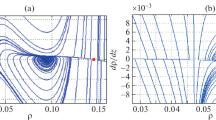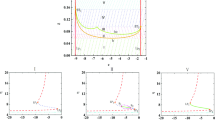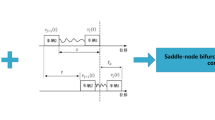Abstract
Traffic congestion not only has a great impact on people's travel, but also increases energy consumption and air pollution. The control analysis of the macroscopic traffic flow model considering the vehicle braking effect is particularly important, reflecting the impact on the actual traffic flow density wave, so as to better solve the actual traffic problems. In this paper, based on a speed difference optimization speed model, the micro–macro-variables are transformed into a high-order continuous traffic flow model. Then, a random function considering the physical correlation of random components is added to the high-order continuous traffic flow model to establish a random traffic flow model that can reflect the uncertain behavior of traffic flow acceleration or deceleration. Based on this stochastic traffic model, the existence of Hopf bifurcation and bifurcation control of the traffic flow system model considering stochastic characteristics are derived by using Hopf bifurcation theorem. By Chebyshev polynomial approximation method, the stochastic problem of the system is transformed into the bifurcation control problem of its equivalent deterministic system. A feedback controller is designed to delay the occurrence of Hopf bifurcation and control the amplitude of the limit cycle. Without changing the equilibrium point of the system, the complete elimination of Hopf bifurcation can be achieved by controlling the amplitude of the limit cycle. That is, the feedback controller is used to modify the bifurcation characteristics of the system, such as the bifurcation appearing at the equilibrium point in the control system moves forward, moves backward or disappears, so as to achieve the effect of preventing or alleviating traffic congestion.
Graphical abstract















Similar content being viewed by others
Data availability
1. The research model comes from reference [30]. 2. The data used to support the findings of this study are included within the article. 3. Simulation data, codes and so on can be obtained from the second author during the period of research. We declare that we have no financial and personal relationships with other people or organizations that can inappropriately influence our work, there is no professional or other personal interest of any nature or kind in any product, service and/or company that could be construed as influencing the position presented in, or the review of, the manuscript entitled. The authors declared that they have no conflicts of interest to this work. We declare that we do not have any commercial or associative interest that represents a conflict of interest in connection with the work submitted.
References
Baidu Map, Transportation Big Data Research Center of Data Science Research Institute of Tsinghua University, Transportation Science of Southeast University, etc. 2022 China Urban Transportation Report [R]
J.A. López-Renteria, F. Verduzco, B. Aguirre-Hernández, Control of the Hopf bifurcation by a linear feedback control. Int. J. Bifurc. Chaos 25(01), 1550006 (2015)
R. Kaur, S. Sharma, Analyses of lattice hydrodynamic model using delayed feedback control with passing. Phys. A 510, 446–455 (2018)
C. Zhai, W.T. Wu, Designing continuous delay feedback control for lattice hydrodynamic model under cyber-attacks and connected vehicle environment. Commun. Nonlinear Sci. Numer. Simul. 95, 105667 (2021)
X.Y. Guan, R.J. Cheng, H.X. Ge, Bifurcation control of optimal velocity model through anticipated effect and response time-delay feedback methods. Phys. A Stat. Mech. Appl. 574, 125972 (2021)
M.A. Silgu, İG. Erdağı, G. Göksu et al., H∞ state feedback controller for ODE model of traffic flow. IFAC-PapersOnLine 54(2), 19–24 (2021)
L.H. Nguyen, K.S. Hong, Hopf bifurcation control via a dynamic state-feedback control. Phys. Lett. A 376(4), 442–446 (2012)
G.H. Chen, J.L. Moiola, H.O. Wang, Bifurcation control: theories, methods, and applications. Int. J. Bifurc. Chaos 10(03), 511–548 (2000)
I. Bashkirtseva, T. Perevalova, Analysis of stochastic bifurcations in the eco-epidemiological oscillatory model with weak allee effect. Int. J. Bifurc. Chaos Appl. Sci. Eng. 32(8), 1–14 (2022)
W.H. Ai, Z.K. Shi, D.W. Liu, Bifurcation analysis method of nonlinear traffic phenomena. Int. J. Mod. Phys. C 26(10), 1550111 (2015)
J. Delgado, P. Saavedra, Global bifurcation diagram for the Kerner–Konhauser traffic flow model. Int. J. Bifurc. Chaos 25, 1793–6551 (2015)
Y. Miura, Y. Sugiyama, Coarse analysis of collective behaviors: bifurcation analysis of the optimal velocity model for traffic jam formation. Phys. Lett. A 381, 3983–3988 (2017)
Y.Q. Wang, B.W. Yan, C.F. Zhou, X.J. Chu, D.C. Zhang, W.K. Li, J.X. Wang, C.H. Fang, B. Jia, Z.Y. Gao, Theoretical analysis of bifurcations in a microscopic traffic model accounting for optimal velocity. Mod. Phys. Lett. B 31, 1793–6640 (2017)
L.F. Cheng, X.K. Wei, H.G. Cao, Two-parameter bifurcation analysis of limit cycles of a simplified railway wheelset model. Nonlinear Dyn. 93, 42415–42431 (2018)
Y.Q. Wang, B.W. Yan, C.F. Zhou, W.K. Li, B. Jia, Bifurcation analysis of a heterogeneous traffic flow model. Mod. Phys. Lett. B 30, 1793–6640 (2018)
Y.C. Zhang, Y. Xue, P. Zhang, D.L. Fan, H.D. He, Bifurcation analysis of traffic flow through an improved car-following model considering the time-delayed velocity difference. Physica A 514, 133–140 (2019)
W.L. Ren, R.J. Cheng, H.X. Ge, Bifurcation analysis of a heterogeneous continuum traffic flow model. Appl. Math. Model. 94, 369–387 (2021)
X.Y. Guan, R.J. Cheng, H.X. Ge, Bifurcation control of optimal velocity model through anticipated effect and response time-delay feedback methods. Physica A 574, 125972 (2021)
L.X. Duan, S.S. Fan, D.Y. Liu, Z.H. He, Two-parameter bifurcation and energy consumption analysis of the macro traffic flow model. Eur. Phys. J. B. 95(12), 203 (2022)
W.H. Ai, Y.F. Ma, D.W. Liu, Bifurcation analysis based on new macro two velocity difference model. Int. J. Geom. Methods Mod. Phys. 14, 2250228 (2022)
W.H. Ai, N. Li, W.S. Duan, Bifurcation analysis of a modified continuum traffic flow model considering driver’s reaction time and distance. Int. J. Mod. Phys. C 34, 2350032 (2022)
W.L. Ren, R.J. Cheng, H.X. Ge, Q. Wei, Bifurcation control in an optimal velocity model via double time-delay feedback method. IEEE Access 8, 216162–216175 (2020)
X.Y. Guan, R.J. Cheng, H.G. Ge, Bifurcation control ofoptiml velocity model through anticipated effect and response time-delay feedback methods. Phys. A Stat. Mech. Appl. 574, 125972 (2021)
G.F. Newel, Nonlinear effects in the dynamics of car following. Oper. Res. 9, 209–229 (1961)
M. Bando et al., Dynamical model of traffic congestion and numerical simulation. Phys. Rev. E 51, 1035–1042 (1995)
M. Muramatsu, T. Nagatani, Soliton and kink jams in traffic flow with open boundaries. Phys. Rev. E 60, 180–187 (1996)
T. Komatasu, S. Sasa, Kink solution charactering traffic congestion. Phys. Rev. E 52, 5574–5581 (1995)
A. Schadschneider, Traffic flow: a statistical physics point of view. Phys. A Stat. Mech. Appl. 313(1–2), 153–187 (2002)
D. Helbing, B. Tilch, Generalized force model of traffic dynamics. Phys. Rev. E 58, 133–138 (1998)
T. Nagatani, The physics of traffic jams.Rep. Progress Phys. 65, 1331–1386 (2002)
D. Ngoduy, Noise-induced instability of a class of stochastic higher order continuum traffic models. Transp. Res. Part B Methodol. 150, 60–278 (2021)
C.F. Daganzo, J.A. Laval, Moving bottlenecks: a numerical method that converges in flows. Transp. Res. Part B Methodol. 39(9), 855–863 (2005)
B.D. Hassard, N.D. Kazarinoff, Y.H. Wan, Theory and Application of Hopf Bifurcation (Cambridge University Press, Cambridge, 1981)
J. Guckenheimer, P. Holmes, Nonlinear Oscillations, Dynamical Systems, and Bifurcations of Vector Fields (Springer, New York, 2013)
Z. Jing, Z. Liu, Qualitative analysis for a mathematical model of aids. Acta Math. Appl. Sin. 9(4), 302–316 (1993)
J. Shen, Z. Jing, A new detecting method for conditions of existence of Hopf bifurcation. Acta Math. Appl. Sin. 11(1), 79–93 (1995)
J.F. Cao, C.Z. Han, Y.W. Fang, Nonlinear System Theory and Application (Xi’an Jiaotong University Press, Xi’an, 2006)
W. Xu, Some Numerical Methods and Applications of Nonlinear Stochastic Dynamics (Science Press, Beijing, 2013)
B.S. Kerner, P. Konhäuser, Cluster effect in initially homogeneous traffic flow. Phys. Rev. E 48(4), R2335 (1993)
B.S. Kerner, P. Konhäuser, Structure and parameters of clusters in traffic flow. Phys. Rev. E 50(1), 54 (1994)
Author information
Authors and Affiliations
Contributions
WA participated in the research, proposed research topics, designed the research scheme, implemented the research process and contributed to the final paper. MW contributed to the article writing, performed the research, collated the literature, designed the paper framework, drafted the paper, revised the thesis and organized the data. DL supported the work, performed the statistical analysis, contributed to the access to research funding, technical or material support and instructional support.
Corresponding author
Rights and permissions
Springer Nature or its licensor (e.g. a society or other partner) holds exclusive rights to this article under a publishing agreement with the author(s) or other rightsholder(s); author self-archiving of the accepted manuscript version of this article is solely governed by the terms of such publishing agreement and applicable law.
About this article
Cite this article
Ai, W., Wang, M. & Liu, D. Hopf bifurcation control of macroscopic traffic flow model considering vehicle braking effect. Eur. Phys. J. E 46, 130 (2023). https://doi.org/10.1140/epje/s10189-023-00393-5
Received:
Accepted:
Published:
DOI: https://doi.org/10.1140/epje/s10189-023-00393-5




